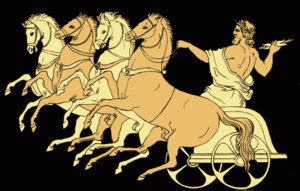Kereta perang
Kereta perang adalah kendaraan beroda dua atau empat yang cepat, ringan, dan terbuka, yang ditarik oleh dua ekor kuda atau lebih, yang saling berdampingan. Tempat untuk pengemudinya berupa pijakan dengan perlindungan setinggi pinggang berbentuk setengah lingkaran di bagian depannya. Kereta perang adalah jenis pedati terawal dan yang paling sederhana. Kereta ini paling dikenal karena penggunaannya dalam perang, meskipun kendaraan ini juga sering digunakan untuk keperluan nonmiliter pada masa kuno. Gerobak sapi, bentuk awal dari kereta perang, dibuat oleh orang India-Eropa-Purba dan juga digunakan di Mesopotamia sejak 3000 SM. Kereta perang, dikemudikan oleh seorang sais, digunakan untuk peperangan kuno pada Zaman Perunggu dan Zaman Besi, dengan dilindungi oleh perisai. Setelah tak lagi terlalu berguna dalam perang, kereta perang terus digunakan untuk perjalanan, arak-arakan dan dalam olahraga dan balapan. Di Romawi kuno dan beberapa negara Mediterania kuno, kereta perang dengan dua kuda disebut biga, tiga kuda disebut triga, dan empat kuda disebut quadriga.

Inovasi penting yang memungkinkan konstruksi kereta ringan untuk perang adalah penggunaan roda berjari-jari. Penggunaan terawal kereta perang dengan roda berjari-jari adalah pada ca. 2000 SM. Sementara puncak penggunaan kereta perang terjadi sekitar 1300 SM. Kereta perang tak lagi digunakan untuk keperluan militer sejak abad ke-4 M. namun balap kereta perang tetap populer di Konstantinopel sampai abad ke-6 M.
Referensi
sunting- Anthony, D. W., & Vinogradov, N. B., Birth of the Chariot, Archaeology vol.48, no.2, Mar & April 1995, 36-41
- Anthony, David W., 1995, Horse, wagon & chariot: Indo-European languages and archaeology, Antiquity Sept/1995
- Di Cosmo, Nicolo, The Northern Frontier in Pre-Imperial China, Cambridge History of Ancient China ch. 13 (pp. 885–966).
- Litauer, M.A., & Grouwel, J.H., The Origin of the True Chariot', "Antiquity" vol.70, No.270, December 1996, 934-939.
- Sparreboom, M., Chariots in the Veda, Leiden (1985).
Bacaan lanjutan
sunting- Anthony, David W. The Horse, The Wheel and Language: How Bronze-Age Riders from the Eurasian Steppes Shaped the Modern World Princeton: Princeton University Press, 2007 (ISBN 978-0-691-05887-0).
- Chamberlin, J. Edward. Horse: How the horse has shaped civilizations. N.Y.: United Tribes Media Inc., 2006 (ISBN 0-9742405-9-1).
- Cotterell, Arthur. Chariot: From chariot to tank, the astounding rise and fall of the world's first war machine. Woodstock & New York: The Overlook Press, 2005 (ISBN 1-58567-667-5).
- Crouwel, Joost H. Chariots and other means of land transport in Bronze Age Greece (Allard Pierson Series, 3). Amsterdam: Allard Pierson Museum, 1981 (ISBN 90-71211-03-7).
- Crouwel, Joost H. Chariots and other wheeled vehicles in Iron Age Greece (Allard Pierson Series, 9). Amsterdam: Allard Pierson Museum:, 1993 (ISBN 90-71211-21-5).
- Drews, Robert. The coming of the Greeks: Indo-European conquests in the Aegean and the Near East. Princeton: Princeton University Press, 1988 (hardcover, ISBN 0-691-03592-X); 1989 (paperback, ISBN 0-691-02951-2).
- Drews, Robert. The end of the Bronze Age: Changes in warfare and the catastrophe ca. 1200 B.C. Princeton: Princeton University Press, 1993 (hardcover, ISBN 0-691-04811-8); 1995 (paperback, ISBN 0-691-02591-6).
- Drews, Robert. Early riders: The beginnings of mounted warfare in Asia and Europe. N.Y.: Routledge, 2004 (ISBN 0-415-32624-9).
- Lee-Stecum, Parshia (2006). "Dangerous Reputations: Charioteers and Magic in Fourth-Century Rome". Greece & Rome. 53 (2): 224–234. doi:10.1017/S0017383506000295. ISSN 0017-3835.
- Fields, Nic; Brian Delf (illustrator). Bronze Age War Chariots (New Vanguard). Oxford; New York: Osprey Publishing, 2006 (ISBN 978-1-84176-944-8).
- Greenhalg, P A L. Early Greek warfare; horsemen and chariots in the Homeric and Archaic Ages. Cambridge University Press, 1973. (ISBN 978-0-521-20056-1).
- Kulkarni, Raghunatha Purushottama. Visvakarmiya Rathalaksanam: Study of Ancient Indian Chariots: with a historical note, references, Sanskrit text, and translation in English. Delhi: Kanishka Publishing House, 1994 (ISBN 978-81-7391-004-3)
- Littauer, Mary A.; Crouwel, Joost H. Chariots and related equipment from the tomb of Tutankhamun (Tutankhamun's Tomb Series, 8). Oxford: The Griffith Institute, 1985 (ISBN 0-900416-39-4).
- Littauer, Mary A.; Crouwel, Joost H.; Raulwing, Peter (Editor). Selected writings on chariots and other early vehicles, riding and harness (Culture and history of the ancient Near East, 6). Leiden: Brill Academic Publishers, 2002 (ISBN 90-04-11799-7).
- Moorey, P.R.S. "The Emergence of the Light, Horse-Drawn Chariot in the Near-East c. 2000–1500 B.C.", World Archaeology, Vol. 18, No. 2. (1986), pp. 196–215.
- Piggot, Stuart. The earliest wheeled transport from the Atlantic Coast to the Caspian Sea. Ithaca, NY: Cornell University Press, 1983 (ISBN 0-8014-1604-3).
- Piggot, Stuart. Wagon, chariot and carriage: Symbol and status in the history of transport. London: Thames & Hudson, 1992 (ISBN 0-500-25114-2).
- Pogrebova M. The emergence of chariots and riding in the South Caucasus in Oxford Journal of Archaeology, Volume 22, Number 4, November 2003, pp. 397–409.
- Raulwing, Peter. Horses, Chariots and Indo-Europeans: Foundations and Methods of Chariotry Research from the Viewpoint of Comparative Indo-European Linguistics. Budapest: Archaeolingua, 2000 (ISBN 963-8046-26-0).
- Sandor, Bela I. The rise and decline of the Tutankhamun-class chariot in Oxford Journal of Archaeology, Volume 23, Number 2, May 2004, pp. 153–175.
- Sandor, Bela I. Tutankhamun's chariots: Secret treasures of engineering mechanics in Fatigue & Fracture of Engineering Materials & Structures, Volume 27, Number 7, July 2004, pp. 637–646.
- Sparreboom M. Chariots in the Veda (Memoirs of the Kern Institute, Leiden, 3). Leiden: Brill Academic Publishers, 1985 (ISBN 90-04-07590-9).
Pranala luar
sunting- (Inggris) Kereta perang Mesir kuno: sejarah, penggunaan, desain, dll
- (Inggris) Chariot Usage in Greek Dark Age Warfare, oleh Carolyn Nicole Conter: Title page for Electronic Theses and Dissertations ETD etd-11152003-164515. Diarsipkan 2012-07-17 di Wayback Machine. Florida State University ETD Collection.
- (Inggris) Kereta perang di Yunani. Diarsipkan 2005-05-07 di Wayback Machine. Hellenica - Michael Lahanas.
- (Inggris) Kamat Research Database - Prehistoric Carts. Varieties of Carts and Chariots in prehistoric cave shelter paintings found in Central India. Kamat's Potpourri – The History, Mystery, and Diversity of India.
- (Inggris) Ludi circenses (longer version). SocietasViaRomana.net.
- (Inggris) Remaking the Wheel: Evolution of the Chariot - New York Times. 22 Februari 1994.